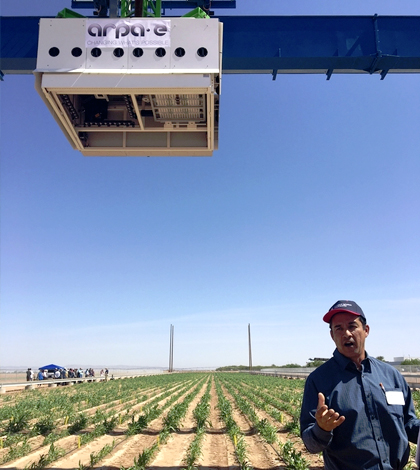Massive Field Scanalyzer Studies Sorghum’s Energy Potential

Pedro Andrade-Sanchez, precision agriculture specialist at the Maricopa Agricultural Center, discusses the operation and measurement capabilities of the field scanalyzer. (Credit: Susan McGinley / University of Arizona)
Feeding all the people on this planet isn’t going to get easier, not with a population projected to explode to 9.22 billion by 2075 according to United Nations’ estimates. But science is trying to find a way. In one example, a consortium of researchers has employed hyperspectral imaging, technology found on satellites, on a massive field scanalyzer built in the Arizona desert.
The scanalyzer is in use at the University of Arizona’s Maricopa Agricultural Center (MAC) near Phoenix, mounted on a 30-ton steel gantry and moving along steel rails 200 meters long. It is the world’s largest robotic field scanner to date and its construction allows it to observe the growing patterns of more than an acre of sorghum.
Sorghum is a drought-resistant plant used the world over in flour, couscous or porridge. But new varieties of the plant have helped to make strains of it much richer in energy content than before. The sorghum planted in the field comprise 176 lines, cultivars and hybrids of the plant.
About 1.25 acres, or somewhere around 30,000 to 40,000 plants, are being scanned. The field scanner can sense and continuously image plant growth and development, generating an enormous stream of high-resolution data — about 5 terabytes each day. The data feed into the Maricopa Phenomics Center, a collaboration between MAC and the U.S. Department of Agriculture – Agricultural Research Service. Researchers at the University of Illinois are helping out with analyzing the massive dataset as well.
With all the varieties planted there, scientists expect to see numerous differences in sorghum plant height, leaf surface area, biomass, heat tolerance and responses to local conditions. And that’s a good thing, as investigators see the field as a living laboratory that can be used to help answer many energy crop questions.
One of the University of Arizona’s roles in the work is to provide and maintain the infrastructure and data collection network of the field scanalyzer. But scientists there are also working to establish and conduct plant experiments, which involves complex experimental designs and precise placement of seeds in the ground that are georeferenced.

The world’s largest robotic field scanner (white steel box) is mounted on a 30-ton steel gantry moving along 200-meter steel rails over 1.5 acres of sorghum at the Maricopa Agricultural Center. (Credit: Susan McGinley / University of Arizona)
In the past, someone would have to go out with a clipboard and a pencil to manually record those metrics. But nowadays, the field scanalyzer has made that sort of data collection obsolete. Now there are several scanning instruments that can track a crop and take notes automatically. Scientists call the approach “high-throughput phenotyping,” and it allows them to quickly characterize all the plants a couple times a day while removing human error. Beyond that, the scanner can note water stress of some plants for comparison to that of varieties that are drought-tolerant, allowing for analysis of common genes.
U. of Arizona researchers say that the system was installed in Maricopa because it is one of the best locations in the United States to do drought and heat studies. The climate and the natural conditions of the low desert provide the best conditions to image the crops. The ideal conditions also make it possible for scientists to phenotype the plants right where they are.
So far, researchers have the genes of the plants nailed down. But their next steps are to pinpoint the physical characteristics of sorghum crops, like height, leaf behavior and how quickly they can grow. Ultimately, they are hoping to examine more than just leaf characteristics in a field. The technology could eventually be used for seed germination and breeding below-ground root systems that spread deeper or wider to more easily combat drought.
Eventually, those working on the project would like to see the field scanner scaled down to meet specific objectives in crop management, like breeding applications. Prospective plants for such attention include grains, leafy vegetables and loblolly pines, one of the most common tree species in the U.S.
The field scanalyzer is part of a U.S. Department of Energy Advanced Research Projects Agency-Energy (ARPA-E) program known as Transportation Energy Resources from Renewable Agriculture (TERRA). The overall goal of the multi-institutional effort that includes the University of Arizona is to identify crop physical traits best suited to produce high-energy, sustainable biofuels.
Top image: Pedro Andrade-Sanchez, precision agriculture specialist at the Maricopa Agricultural Center, discusses the operation and measurement capabilities of the field scanalyzer. (Credit: Susan McGinley / University of Arizona)




0 comments